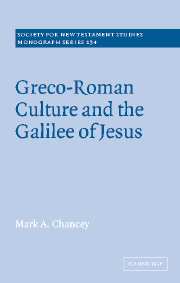Book contents
- Frontmatter
- Contents
- Preface
- Abbreviations
- Map of Galilee and northern Palestine
- Introduction
- 1 Galilee's early encounter with Hellenism
- 2 The Roman army in Palestine
- 3 The introduction of Greco-Roman architecture
- 4 The transformation of the landscape in the second and third centuries CE
- 5 The use of Greek in Jesus' Galilee
- 6 The coinage of Galilee
- 7 Greco-Roman art and the shifting limits of acceptability
- 8 Conclusion
- Appendix: Galilean names in the first century CE
- Select bibliography
- Index of passages
- Selective index of places
- Index of people and topics
7 - Greco-Roman art and the shifting limits of acceptability
Published online by Cambridge University Press: 22 September 2009
- Frontmatter
- Contents
- Preface
- Abbreviations
- Map of Galilee and northern Palestine
- Introduction
- 1 Galilee's early encounter with Hellenism
- 2 The Roman army in Palestine
- 3 The introduction of Greco-Roman architecture
- 4 The transformation of the landscape in the second and third centuries CE
- 5 The use of Greek in Jesus' Galilee
- 6 The coinage of Galilee
- 7 Greco-Roman art and the shifting limits of acceptability
- 8 Conclusion
- Appendix: Galilean names in the first century CE
- Select bibliography
- Index of passages
- Selective index of places
- Index of people and topics
Summary
In the first century CE, Galileans seem to have had a conservative attitude towards Greco-Roman art, particularly in regard to figural representations – that is, depictions of animals, humans, deities, and mythological figures. As we have seen, such images were absent even from coins struck in Galilee, despite the fact that Galileans encountered them frequently on coins minted outside the region. In the early second century, however, they began appearing on Galilean coins, and by the late second and the third centuries, they were found on a variety of media, such as sarcophagi, mosaics, and lamps. The timing of this trend strongly suggests that it, too, should be considered within the context of Romanization. This chapter will explore the development of Greco-Roman art in Galilee, paying special attention to the shifting boundaries of acceptability regarding anthropomorphic and zoomorphic imagery.
JEWISH ART AND FIGURAL REPRESENTATION IN THE FIRST CENTURY CE
The most significant difference between the art of first-century CE Jews in Palestine and the art of most (though not all) other areas of the Roman world was the avoidance of figural art. For Jews, this avoidance was grounded in the Torah's prohibitions of “graven images” (Exodus 20:4–6, Deuteronomy 4:15–18), a category interpreted broadly in this period to include representation in a variety of media – mosaics, frescoes, reliefs, statues, and figurines. This attitude comes across clearly in Josephus's descriptions of Herodian and first-century Palestine, as Steven Fine points out.
- Type
- Chapter
- Information
- Greco-Roman Culture and the Galilee of Jesus , pp. 193 - 220Publisher: Cambridge University PressPrint publication year: 2005



